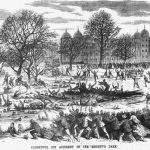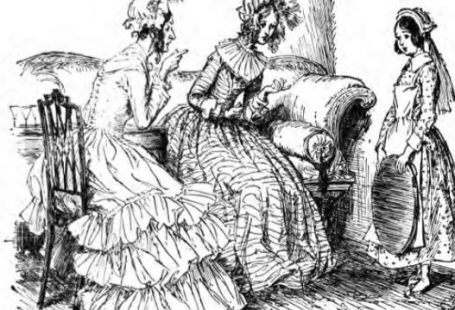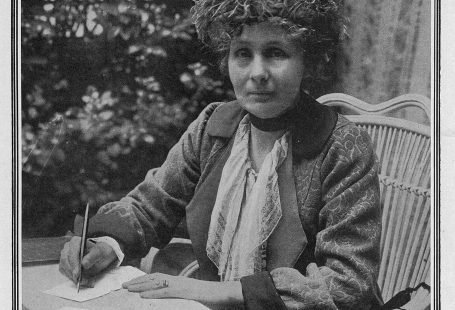On Christmas Day 1906 the city of Sheffield in the north of England saw the ‘heaviest Christmas snow for 25 years,’ as the Sheffield Daily Telegraph reports:
On the evening of Christmas Day the snow began to fall, and yesterday morning the city was covered in a beautiful mantle of the purest white. Snow lay on the ground to the depth of about six inches, and, except in the streets, so remained until last night, when there was a further fall.
Long before the Irving Berlin-written, Bing Crosby-sung, hit of ‘White Christmas’ was released in 1942, this snowy Christmas weather was referred to as ‘Good Old Fashioned Christmas Weather.’
Illustrated London News | 9 November 1956
But, in Britain, are we right to connect snowfall with Christmas? Is there a historical precedence for our dreams of a white Christmas?
In this special blog we will attempt to sort the fact from the fiction, the myth from the reality, as we explore the truth behind the popular image of a white Christmas, using newspapers taken from our Archive.
Britannia and Eve | 1 December 1950
Register now and explore The Archive
Popular Fancy
As the snow fell in Sheffield in late 1906, the Sheffield Daily Telegraph writes how it is only ‘popular fancy [which] invests Christmas with ideas of snow.’ Even with the snowflakes falling, the newspaper is sounding a note of caution, reporting how ‘this is only the second Christmas on which there has been an appreciable amount of snow for a quarter of a century.’ The newspaper looks back to 1899 when ‘snow fell heavily on the evening of Christmas Day.’
The snow came as the night fell, bringing ‘the greatest of gifts (to some people) on Boxing Day.’ The Sphere, like the Sheffield Daily Telegraph, calls this an ‘old-fashioned Christmas,’ with the ‘young people’ taking to Hampstead Heath on their toboggans, or indeed using ‘everything in the shape of a box’ to take advantage of the snowy conditions.
‘Tobogganing on Parliament Hill’ by J Barnard Davis | The Sphere | 5 January 1907
Meanwhile the snowy Christmas weather robbed the King, Edward VII, of his favourite pastime, as the traditional Boxing Day shoot at Sandringham was cancelled. The Sphere also tells of the unhappiness of the London rate payers, with the Christmas snow set to cost the borough councils ‘some £5,000.’
So we see some examples of a white Christmas already in our Archive, but already in 1906 such an event was seen as ‘old-fashioned,’ and somewhat historic. But why was this?
Fifty Years of Christmas Weather
In January 1890 The Cornish Telegraph outlined the ‘last fifty years‘ of Christmas weather:
In the fifty years there have been eleven brilliantly fine Christmas days, ten fair, and twenty-six days when the weather has been ‘dull.’ Snow fell only five Christmas days in fifty years, though the ground may have been white on other occasions through previous falls.
‘Christmas Weather – Snowballing’ by G. Dodgson | Illustrated London News | 24 December 1853
So, a proper white Christmas only occurred on five days out of fifty. The weather report from 1869 certainly bears this out, the Carlisle Patriot noting the ‘capriciousness of Christmas weather…where we have had in succession snow, rain, hail and gales of wind.’
Indeed, during the nineteenth century there were also unseasonably warm Christmases. Arthur Gaunt, writing for the Shields Daily News in 1955, recalls the Christmas of 1844, which was ‘so mild that picnics were held and London’s Rotton Row was the scene of a fashion parade of ladies dressed in summer finery.’ The temperature that year reached ‘over 60 degrees.’
Gaunt also reminisces about the ‘‘rose’ Christmas of 1913, when roses bloomed and primroses grew in the woods.’
Daily Mirror | 31 December 1913
In 1922, the lack of snow for Christmas made headline news in the Pall Mall Gazette, the words ‘No Snow’ adorning the front page, as ‘London’s hopes (and fears) for a ‘old-fashioned’ Christmas are fading away.’
The record of these ‘white Christmases’ are very London centric, with snowy weather of course occurring on Christmas Day across other parts of the British Isles. London is at the heart of Sir Richard A. Gregory’s famous survey of Christmas weather, using data gathered from the Greenwich Observatory.
In 1924 the Portsmouth Evening News tells of how Sir Richard ‘corrects a conventional belief’ in his address to the annual meeting of the Geographical Association:
Little meteorological evidence existed, he said, for the association of snow with Christmas. In a period of 83 years snow fell on Christmas Eve on two occasions only; there were only six years in which it had fallen on Christmas Day, and ten when there had been snow on Boxing Day.
Throughout the twentieth century Sir Richard’s findings were often quoted, as the myth of a white Christmas grew and journalists sought to contradict such popular imaginings. Indeed, Guy Livingstone writing for Britannia and Eve in 1950 states how ‘in many places it falls more often in March than in any other month.’
A Dickens Christmas
So where do we get this myth of a white Christmas from, if it is not supported by meteorological facts? We all have a very strong idea of how Christmas should be. Alan Kemp, writing for The Sketch in 1929, paints a very vivid (if somewhat satiric) picture of the ‘specification’ for Christmas weather:
A pure white mantle of snow lies o’er the land. This is essential, otherwise S. Claus’s sleigh looks silly, and Good King Wenceslas is out of a job. On the window-sill is a glistening layer of snow, and hereon hops a robin redbreast in straitened circumstances, begging a few crumbs. Outside in the streets the crossing-sweeper, a merry soul beloved of all, exchanges a cheerful greeting with everybody, and is pelted with coin of the realm.
Illustrated London News | 25 December 1954
In the garden, the children have erected a life-size snow man, and are now putting the finishing touch of verisimilitude by thrusting father’s best pipe into his mouth and crowning him with the bowler which father thought might just last out the winter. Inside, a gigantic Yule log crackles on the hearth and steaming punch-bowl stands ready and invited. If that is not the specification for Christmas, then Charles Dickens lived in vain.
It’s a scene we recognise from every Christmas card – and from the writings of Charles Dickens. We recall the snow falling during his classic tale A Christmas Carol, and as Arthur Gaunt writes in 1954 ‘The idea that snowfalls in the United Kingdom at Christmas probably arises in no small measure from the writings of Charles Dickens.’
A Christmas morning walk to church | Illustrated London News | 3 December 1887
But we know that snow falling on Christmas Day during the Victorian era was something of a rarity, so why was Dickens writing about it at all? Well, Gaunt claims to have the answer, as Dickens’s ‘own early days happened to coincide with a series of hard winters.’
Trick of Time
So indeed there was a time when snow fell regularly at Christmas, and Arthur Gaunt for the Shields Daily News has a theory as to why this changed: the switch from the Julian to the Gregorian Calendar.
He writes how snow ‘was common at Yuletide,’ but after 1752 it became less and less common:
…not as a result of any big change in the weather, but because 11 days were dropped from the calendar. Until that change, the day which is now December 25 fell later, arriving on the day now marked on our calendars as January 5, and severe weather is much more likely to be experienced on that date than in the last week of December.
He also makes the point that ‘throughout the centuries we have have been accustomed to remembering the great snowfalls’ and associating them with Christmas, making a white Christmas seem ‘typical, whereas in reality it is unusual.’
Snowflakes on December Twenty-Fifth
So with Dickens long since paving the way for the expectation of a white Christmas, and snow during the festive season imprinted on our collective memory over the centuries, along came the classic film White Christmas, starring Bing Crosby, Rosemary Clooney, Danny Kaye and Vera-Ellen in 1954.
Danny Kaye and Vera-Ellen in White Christmas | The Sketch | 3 November 1954
The film was an instant hit, as The Sketch reports in November 1954:
…there are silver linings and song-and-dance routines all over the place, and the film itself has ‘popular success’ written all over it. No Expense, as the saying goes, Has Been Spared. It has the New, Revolutionary, Vista-Vision. It has that old stand-by, Technicolour. It has a lot of the brand-new – and a few grand old – songs of the ‘hit’ variety…It has, in fact, everything – including snowflakes on December twenty-fifth.
This cemented the myth of a white Christmas in the popular imagination. That year, The Sphere was printing ‘picturesque scenes’ of snow-clad rural England, under the header ‘Christmas weather,’ when it was in fact November. The myth had become a reality, but not everybody was happy about it.
‘Christmas Weather’ in Lacock, Wiltshire | The Sphere | 18 November 1954
Nothing to Dream About
In 1880 the St Andrews Gazette and Fifeshire News published a rather mournful poem by Violet Fane entitled ‘Snow at Christmas:’
Snowflakes are laden bough and whitened ledge;
Poor Robin Redbreast chirping for his crumbs;
Imprisoned waters under drooping sedge;
Sad children, carolling in cold that numbs
And hangs the icicles upon the spray…
This short extract revels the harshness of a snowy Christmas, that even when snow does occur during the festive season, it is not always something to be happy about.
1927 saw snow at Christmas, and it was a particularly harsh snow at that. Two years later Alan Kemp recalls how ‘the roads were impassable not only to sleighs but to every other kind of traffic,’ conjuring up images of ‘the butcher and baker and milkman’ all disappearing ‘into a crevasse.’
Guy Livingstone in 1950 backs up Alan Kemp, remembering how the ‘‘polar front’ stood across southern England…blocking roads and railways, cutting off villages, burying cattle.’ That year, he says, ‘a white Christmas was no dreaming matter.’
Stephen Watts, writing for The Sketch in 1956 goes further, demanding ‘Why do we yearn, in theory at least, for weather which normally, to be honest, we don’t much like?’ Meanwhile Maurice Lane-Norcott in 1936 wrote an impassioned piece for The Bystander entitled ‘Must We Have Snow at Christmas?’
Clearing a lane in Reigate during the 1927 Christmas snow | Britannia and Eve | 1 December 1950
His entire theme is based on the lines ‘Snow, Snow go away!’ – bemoaning how the stuff ‘just falls out of the sky for no apparent reason at all and gets under our feet… The most that anyone can hope to do with snow is to pick up a handful and throw it at somebody.’
He wishes his readers a ‘merry snow-less Christmas,’ whilst other writers were wishing for snow, but only on their Christmas cards.
Our Kind of Christmas
And indeed, the Christmas which we envision, as Stephen Watts writes, represents ‘conventional, Western European sentimentalities.’ Christmas to us in the north of Europe should be cold and snowy, but Christmas itself is global, and as such, is celebrated in climates which are very far from being snow-bound.
Stephen Watts in 1956 expands on this idea:
…we hear of Australians eating their plum pudding with ice-cream on Bondi Beach in blazing sun – although we have known about the seasons and the hemispheres from school-days – we still hold to our conceptions of what Christmas ought to look and feel like…It’s not a proper Christmas, we seem to say, unless it’s our kind.
Christmas dinner in Centennial Park, Sydney | Illustrated London News | 9 November 1956
And so strong are these myths of a white Christmas they have even permeated cultures where there would never be any snow over the festive period, with Santa Claus and his sleigh joining the ‘battles of flowers and picnic parties’ in the ‘sunny celebrations‘ of Brazil.
Whilst of course this owes something to the legacy of post-colonialism, which must not be ignored, many of our snowy Christmas customs and associations (mistletoe, holly, the Yule log) all stem from not the Christian celebration of Christmas, but the pagan celebrations of the winter season, which you can read more about here.
So although Christmas itself was born in Bethlehem, its customs were not, and its eternal association with winter is born out of traditions which pre-date Christianity. And of course, we cannot forget the influence of popular culture, from Charles Dickins to Bing Crosby, to Michael Buble today in establishing the white Christmas myth, which means we will forever be dreaming of a white Christmas, although we might be very far from actually getting one!



















